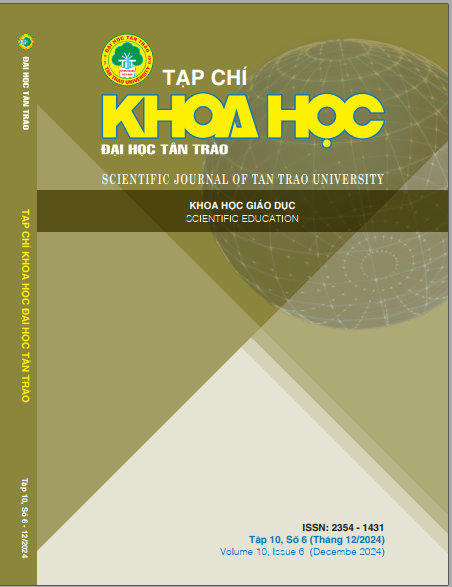THỰC TRẠNG GIÁO DỤC KĨ NĂNG GIẢI QUYẾT VẤN ĐỀ CHO TRẺ 5-6 TUỔI THÔNG QUA HOẠT ĐỘNG TRẢI NGHIỆM Ở MỘT SỐ TRƯỜNG MẦM NON TRÊN ĐỊA BÀN THÀNH PHỐ TUYÊN QUANG
DOI:
https://doi.org/10.51453/2354-1431/2024/1280Tóm tắt
THỰC TRẠNG GIÁO DỤC KĨ NĂNG GIẢI QUYẾT VẤN ĐỀ CHO TRẺ 5-6 TUỔI THÔNG QUA HOẠT ĐỘNG TRẢI NGHIỆM Ở MỘT SỐ TRƯỜNG MẦM NON TRÊN ĐỊA BÀN THÀNH PHỐ TUYÊN QUANG
Tải xuống
Tài liệu tham khảo
A.V.Petorovski. (1982). Tâm lý học lứa tuổi và tâm lý học sư phạm. NXB Giáo dục.
Đinh Lan Anh (2019). Thực trạng giáo dục kĩ năng giải quyết vấn đề cho trẻ 5-6 tuổi trong trò chơi đóng vai có chủ đề ở một số trường mầm non tại Hà Nội. Tạp chí Giáo dục, Số đặc biệt tháng 9 năm 2019.
Donald J. Treffinger, P. P. (2003). Practice Problems of Creative Problem Solving. New York.
Trương Thị Hoa Bích Dung (2012). Hướng dẫn và rèn luyện kỹ năng sống cho trẻ mầm non. NXB Đại học Quốc gia Hà Nội.
Phan Thị Thuý Hằng (2017). Các biện pháp phát triển kĩ năng giải quyết vấn đề cho trerb 5-6 tuổi thông qua hoạt động làm quen với toán. Tạp chí Giáo dục, Số 404, kì 2, tháng 4 năm 2017.
Đỗ Chiêu Hạnh. (2024). Tổng quan nghiên cứu về phát triển năng lực. Tạp chí khoa học quản lý giáo dục, 47-58.
J.D. Bransford, S. L. (2002). How to solve a problem. International university of Alliant, San Diego.
Larson, L. C. (1997). Problem-solving through problems. New York.
Lomov, B. (2000). Những vấn đề lý luận và phương pháp luận tâm lý học. Hà Nội: NXB Đại học Quốc gia Hà Nội.
Phan Khắc Nghệ (2012). Một số biện pháp bồi dưỡng năng lực phát hiện và giải quyết vấn đề cho học sinh trong dạy sinh học. Tạp chí Giáo dục, số 285, tr 55-57.
Huỳnh Văn Sơn (2012). Phát triển kỹ năng mềm cho sinh viên Đại học Sư phạm Thành phố Hồ Chí Minh. NXB Giáo dục Việt Nam.
Whitten, S. a. (2005). Comprehension of text in problem solving- The psychology of problem solving,. Cambridge Unbiversity Press.
Tải xuống
Đã Xuất bản
Cách trích dẫn
Số
Chuyên mục
Giấy phép

Tác phẩm này được cấp phép theo Giấy phép Quốc tế Creative Commons Attribution-ShareAlike 4.0 .
Bài báo được xuất bản ở Tạp chí Khoa học Đại học Tân Trào được cấp phép theo giấy phép Ghi công - Chia sẻ tương tự 4.0 Quốc tế (CC BY-SA). Theo đó, các tác giả khác có thể sao chép, chuyển đổi hay phân phối lại các bài báo này với mục đích hợp pháp trên mọi phương tiện, với điều kiện họ trích dẫn tác giả, Tạp chí Khoa học Đại học Tân Trào và đường link đến bản quyền; nêu rõ các thay đổi đã thực hiện và các nghiên cứu đăng lại được tiến hành theo cùng một bản quyền.
Bản quyền bài báo thuộc về các tác giả, không hạn chế số lượng. Tạp chí Khoa học Tân Trào được cấp giấy phép không độc quyền để xuất bản bài báo với tư cách nhà xuất bản nguồn, kèm theo quyền thương mại để in các bài báo cung cấp cho các thư viện và cá nhân.
Mặc dù các điều khoản của giấy phép CC BY-SA không dành cho các tác giả (với tư cách là người giữ bản quyền của bài báo, họ không bị hạn chế về quyền hạn), khi gửi bài tới Tạp chí Khoa học Đại học Tân Trào, tác giả cần đáp ứng quyền của độc giả, và cần cấp quyền cho bên thứ 3 sử dụng bài báo của họ trong phạm vi của giấy phép.






